How to cure migraine
Migraines: general symptoms, causes and methods of successful treatment
Descriptions in terms of headache is a typical of a kind of migraine attack being found even in the writings of the ancient Sumerian civilization which existed more than 3000 years BC. Certainly, though migraine is mentioned in the writings of Hippocrates and Paracelsus, originally the term “migraine” is nowadays seen as the one with the French “root” and in turn out coming from the Greek word “hemicrania” which means having “half head”.
Migraine as it is more or less seen as a severe headache trouble more often localized in one half of the head being sometimes accompanied by nausea and vomiting, heightened sensitivity to light and sound. In such cases the patient does not diagnosed by head trauma or stroke followed by brain tumors. The headache of migraine is not commonly associated with fluctuations in the way of blood pressure gaps or glaucoma attack, or even increased intracranial pressure. Migraine is seen as a type of vascular headache in general and that is the crucial point you have to remember first of all! The basis of it’s occurrence is the one which could not been expanded as “a piece of cake” i.e. the walls of blood vessels feeding the brain, which is why they are beginning to put pressure on surrounding nerve cells.

By all means, migraine is perceived as the disease challenging more than 11% of the total population of our Planet which comprise a huge number in terms of figures overall reflecting more often women. There are two types of migraine: classic and common.
The classic course of the disease occurs in 10% of patients. Phase headache is preceded by a short period of precursors, called the aura. The manifestations of the aura are distinct. In some patients have visual disturbances i.e. “shroud, front sight” before our eyes, “bright bursts”. Other proportion of those interviewed may come with a violation of smell. Some patients complain of hearing loss as well as speech or motor coordination.
Migraine attack lasts from several hours to 3 days. The pain occurs in one half of the head and increases gradually. In the future, it could clearly be localized in the temple, forehead, eye, ear, and in some cases in the neck or shoulder. The pain can be so strong that it begins to be felt throughout the body. It is often accompanied by vomiting, dizziness, diarrhea, frequent urination, or fever. Headache amplified by loud noises or bright lights. After the attack, patients note a feeling of complete exhaustion of mental and physical strength.
Factors provoking the Migraine attack:
- increased sensitivity towards certain types of food. Most often migraine attack is provoked by alcohol;
- sudden weather changes as well as atmosphere pressure;
- physical overstrain, insomnia;
- when the lightening is too bright;
- inhaling odors irritates the respiratory tract;
- trauma;
- women rise to an attack can cause hormonal changes in their body, associated with the menstrual cycle.
Any person suffering from severe or recurrent headaches should seek medical advice and undergo a full medical examination to rule out the possibility of such serious diseases as brain tumor, aneurysm, hematoma, and other migraine attacks lasted for many years. Their character and a diverse and different for different patients. Therefore, approaches to treatment must be strictly individual. We must always try to identify the triggers that can be eliminated. These include a chronic lack of sleep, smoking, alcohol or food rich in tyramine i.e. chocolate, cheese or fish.
Between bouts doctor can prescribe some medications for preventive treatment. This treatment is usually comprise about much less than 100% of expected effect of preventing migraine attacks but also helps to reduce the frequency of their occurrence and reduces the severity of headache at-developed attack. Be aware that during pregnancy to preventive treatment impossible.
If the attack has developed, it is recommended to be in the dark, cool room. On the forehead should put a cold compress. You do not need during an attack to drink coffee, strong tea or orange juice. In many cases, migraines can take an ordinary ice cream. Take heaping tablespoons of ice cream, and rotate it to the soft palate. Hold the cold, until the product has melted. These actions lead to a cooling of the hypothalamus, which, apparently, too, is drawn into the process, and contribute to a rapid cessation of even very severe pain.
Drug treatment episode must begin as early as possible, preferably with the onset of aura or first signs of pain. Currently, there are many drugs that facilitate or completely cropped, migraine attacks. But they can be used only on prescription, as well as medicine, well helps one patient may not only be ineffective in another, but also further strengthen the attack.
To receive analgesics should be treated very cautiously. Conventional analgesics are generally not help with migraines, as in this situation must be taken not vasodilator and vasoconstrictor agent. In addition, the constant use of painkillers reduces the sensitivity of the organism to them, increasing the frequency of pain attacks and increases the occurrence of side effects.
Good alternative with respect to drug treatment pertaining to the migraine is the one of physiotherapeutic procedures and massage or hirudotherapy. These methods have virtually no side effects and promote not only the withdrawal symptoms, and prevention of attacks.
Posted in Head and Brain